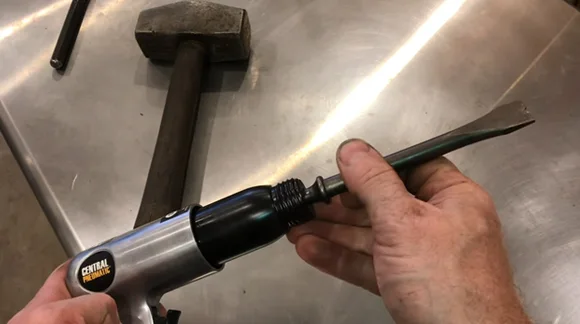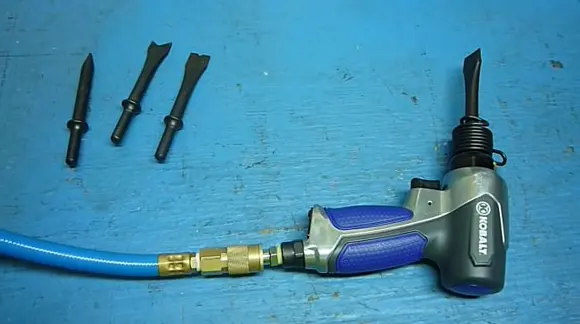Last Updated on January 20, 2023
Air hammers work by using compressed air to push a piston down a cylinder. This creates a hammering action that can break up concrete or drive nails into wood.
Can be used for a variety of different projects, such as breaking up concrete, driving nails into wood, or even chiseling metal.
They are typically used in construction and demolition work. They can also be used for other projects around the home, such as remodeling or repairing a deck.
There are a lot more questions that people have about them. What are they used for? How do they work?
Along with the discussion of some of their benefits and uses. We are here with you answering how does an air hammer work.
Components of Air Hammer and How Do They Work:

Spool Valve:
An air hammer’s spool valve controls the amount of air that flows through the tool. The valve is opened and closed by a trigger, which, when pulled, allows air to flow into the chamber.
This air pressure pushes a piston down the barrel of the hammer, which strikes the chisel bit. Then, when the trigger is released, the air pressure is released and the piston returns to its original position.
Piston:
Air hammers comprise a cylinder, a piston, a trigger, and a nozzle. The piston is connected to the trigger and is sealed at the top of the cylinder.
As soon as the trigger is pulled, the piston is forced down by the pressure of the compressed air, driving the nail into the material.
The nozzle directs air flow and also acts as a buffer, absorbing some impacts of the hammering action.
Piston Chamber:
The air hammer comprises four major components: the piston section, the air compressor, the hammering mechanism, and the barrel. Compressed air is stored in the piston container.
The air compressor pumps air into the chamber, raising the pressure inside. Hammering is triggered when the pressure in the chamber reaches a certain level, causing the hammer to strike.
The barrel helps to guide the nail or concrete chips as they are being broken apart.
Shock Absorption Chamber:
Between the body and the air inlet is the shock-absorbing chamber. It comprises a series of chambers that absorb the shock of impact so that it doesn’t damage the air hammer or the workpiece.
There is an air inlet that is connected to a source of compressed air, such as an air compressor. It supplies compressed air to the shock absorber, which drives the piston.
Drill Bits:
Air hammers typically have two key components: the drill bit and the hammer mechanism. It creates a hole in the material and delivers a powerful blow to break up the material.
In most cases, air hammers are used with different bits, depending on the task at hand. For example, carbide-tipped drill bits are often used for cutting metal, while masonry drill bits are better suited for drilling into concrete.
Anvil:
A hammer is only as good as its anvil. The anvil is the metal surface upon which the workpiece is placed. It provides a stable foundation for the hammer to act upon.
To withstand repeated blows from a hammer without damage, it must be made from a harder material than the workpiece.
It needs to be perfectly flat and smooth so that it does not mar the surface of the workpiece. The face of the anvil is usually slightly concave, to help focus the force of the hammer blow on a small area.
The sides of the anvil are often tapered to provide cutting edges. Anvil backs are typically left flat so that they can be used as a support surface when shaping curved workpieces.
The size and weight also play a role in how well it works. A heavy anvil provides more mass on which to strike the hammer, resulting in more force applying to the workpiece.
Too-heavy anvil can be difficult to maneuver and may damage delicate workpieces.
Read: Do all Rotary Hammer Bits Work the Same?
Uses of Air Hammer Work

Air hammers are versatile tools that great for a variety of purposes. They are built to demolish stuff, yet they can be helpful in other areas as well. Here are different ways you can use an air hammer to make your life easier.
1. Break up Concrete and Asphalt:
As anyone who has attempted to scrape concrete or asphalt knows, it is a difficult and time-consuming task. Air hammers are powerful tools that can easily destroy masonry works and pavement. T
hey can break up hard surfaces quickly and easily. The material is broken up into small pieces by using a high-pressure stream of air. This makes it much easier to remove concrete or asphalt from an area.
First, make sure that you have the correct bit for the job. Then, position the tip of the air hammer on the surface that you want to break up. Then apply pressure and hold it down until the job is done.
2. To Remove Rusted Bolts:
With an air hammer, you can disengage rusted bolts. The high-powered air stream from the air hammer will break through the corrosion, making it easier to remove the bolt.
First, the head of the bolt is heated with a torch until it is glowing red. This helps to loosen the rust and make it easily removable.
Next, the air hammer is placed against bolt heads and activated. The high-pressure air stream dislodges the metal residue and breaks the bond between the bolt and the Todd.
3. To Cut Metal:
Cutting metal is one of the most common tasks that they’re used for. This is because they are very effective at breaking through tough metals, and they can also penetrate multiple layers of metal at once.
There are a few different ways to pound metal by air hammers, but the most common method is to use the chisel attachment.
To do this, simply place the chisel on the metal and start the air hammer. The chisel will quickly break through the metal, and you can then move it along the metal to cut it to the desired shape or size.
Another method of cutting is to use a saw attachment. This is useful for carving thicker metals, as it can quickly make clean slashes without harming the surrounding area.
Simply attach the saw blade to the air hammer and start slicing through the metal. Move the saw back and forth to make wider or narrower cuts as needed.
4. Automobile Workshop:
These air hammers are a very versatile tool suitable for several ways in an automobile workshop. They are most commonly used for removing dents, but they can also remove rust, paint, and other debris from metal surfaces.
These tools can also install or remove trim, molding, and other objects on vehicles. While air hammers are popular in automobile workshops.
5. Remove Paint from Surfaces:
An air hammer drives a piston up and down attached to a chisel, which can remove materials like coatings, and wallpapers.
If you need to remove paint from a surface, just hold the point of the chisel against the target location and start hammering. The vibrating chisel will quickly loosen the paint, making it easy to scrape away.
You may need to use a putty knife or other tool for this task, but air hammers will make quick work of any stubborn residue.
SAFETY and PRECAUTIONS: While Working with Air Hammers

Be sure to wear safety goggles when working with air hammers, as flying pieces of metal can cause serious injury.
If you are working in a confined space, be sure to use ear protection as well, as the noise generated by the tool can be deafening.
Always follow the manufacturer’s instructions carefully, and never exceed the recommended pressure level. With proper safety precautions and use, they can be an extremely useful tool for removing rusted bolts.
Read: What’s the Right Way to Store A Sledgehammer?
FAQs:
There are some frequently asked questions for working with your air hammer. Let’s look at some of them. This section can help users troubleshoot any issues they may have while using their air hammering machine.
How Does Air Flow Impact When Working With an Air Hammer?
Air impacts hammer, that uses compressed air to drive a piston forward. The piston strikes a nail, and the blow is released by pressing the trigger. Airflow impacts the works by providing the force necessary to drive the tool.
The faster the air flows, the more force is exerted to speed up it, and the faster it will travel. The slower the air moves, the less pressure applies to the hammer, and the slower it will travel.
If the flow of air is laminar, then it will provide a smooth flow of force. Turbulent wind will be more erratic and provide less force to the hammer.
2. Do you Need a Compressor for an Air Hammer?
Air hammers already use compressed air from a tank to create the power necessary to operate, so you do not need any compressor.
Pressurized air is regulated by a valve on the hammer that controls how much air is released with each stroke.
This makes it possible to adjust the power of the tool to meet the needs of the job. When not in use, the air hammer should be disconnected from its power source to prevent accidental discharge.
3. How Does an Air Chisel Work?
An air chisel is a handy power tool with a piston driven by compressed air that delivers a sharp blow to a workpiece, usually metal.
This action can chip away at the workpiece or cut through it entirely. Air chisels come in several shapes and sizes and can be outfitted with different tips to accomplish different tasks.
The basic operation of this tool is: To compress air, it is delivered to the tool via an air hose.
4. How Loud is an Air Hammer?
Air hammers can be very loud, often reaching noise levels of 90 decibels or more. For comparison, this is about as loud as a jackhammer or a jet engine.
Exposure to noise at these levels can cause hearing loss, so it is necessary to wear ear protection when using an air hammer.
Conclusion
Besides how does an air hammer work, we also talked about choosing a single air tool for personal use and multiple air tools for industrial use.
We suggest you research a little on the best air hammers according to your usage before you purchase.
It’s important to have a steady hand whenever using pneumatic hammers since they are extremely powerful air tools. One should always practice caution in using power tools such as these. Thanks for reading.



